
Cessna is an American brand of general aviation aircraft owned by Textron Aviation since 2014, headquartered in Wichita, Kansas. Originally, it was a brand of the Cessna Aircraft Company, an American general aviation aircraft manufacturing corporation also headquartered in Wichita. The company produced small, piston-powered aircraft, as well as business jets. For much of the mid-to-late 20th century, Cessna was one of the highest-volume and most diverse producers of general aviation aircraft in the world. It was founded in 1927 by Clyde Cessna and Victor Roos and was purchased by General Dynamics in 1985, then by Textron, Inc. in 1992. In March 2014, when Textron purchased the Beechcraft and Hawker Aircraft corporations, Cessna ceased operations as a subsidiary company, and joined the others as one of the three distinct brands produced by Textron Aviation.

Lancair International, Inc. is a U.S. manufacturer of general aviation aircraft kits. They are well known for their series of high-performance single-engine aircraft that offer cruise speeds that surpass many twin-engine turboprop designs. Along with the Glasair series, the early Lancair designs were among the first kitplanes to bring modern molded composites construction to light aircraft.

Lycoming Engines is a major American manufacturer of aircraft engines. With a factory in Williamsport, Pennsylvania, Lycoming produces a line of horizontally opposed, air-cooled, four, six and eight-cylinder engines including the only FAA-certified aerobatic and helicopter piston engines on the market.
The Cirrus Design Corporation, doing business as Cirrus Aircraft, is an aircraft design, manufacturing, maintenance and management company, as well as a provider of flight training services, that was founded in 1984 by Alan and Dale Klapmeier to produce the VK-30 homebuilt aircraft. The company is headquartered in Duluth, Minnesota, United States, with operational locations in six other states across the US including North Dakota, Tennessee, Texas, Arizona, Florida and Michigan, and additional sales locations in France and the Netherlands. It is majority-owned by a subsidiary of the Aviation Industry Corporation of China (AVIC).

The Cirrus SR20 is an American piston-engined, four- or five-seat composite monoplane built since 1999 by Cirrus Aircraft of Duluth, Minnesota. The aircraft is the company's earliest type-certified model, earning certification in 1998.

The Cessna 400, marketed as the Cessna TTx, is a single-engine, fixed-gear, low-wing general aviation aircraft built from composite materials by Cessna Aircraft. The Cessna 400 was originally built by Columbia Aircraft as the Columbia 400 until December 2007. From 2013, the aircraft was built as the Cessna TTx Model T240.

A very light jet (VLJ), entry-level jet or personal jet, previously known as a microjet, is a category of small business jets that seat four to eight people. VLJs are considered the lightest business jets and are approved for single-pilot operation.

The Columbia Aircraft Manufacturing Corporation was an aircraft manufacturer that designed and built light general aviation aircraft. In November 2007 it became a division of Cessna.

The Cirrus VK-30 is a single-engine pusher-propeller homebuilt aircraft originally sold as a kit by Cirrus Design, and was the company's first model, introduced in 1987.
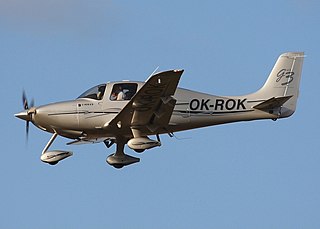
The Cirrus SR22 is a single-engine four- or five-seat composite aircraft built since 2001 by Cirrus Aircraft of Duluth, Minnesota, United States.
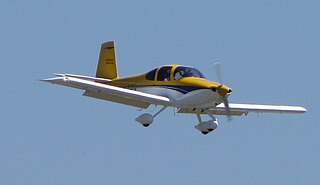
The Van's Aircraft RV-10 is a four-seat, single-engine, low-wing homebuilt airplane sold in kit form by Van's Aircraft. It is the first four-seat airplane in the popular RV series. The RV-10 first flew on 29 May 2003, and the first kit parts were delivered to a customer in September 2003.

The Cessna 162 Skycatcher is an American side-by-side two-seat, high-wing, strut-braced, tricycle gear light-sport aircraft (LSA) that was designed and produced by Cessna between December 2009 and December 2013. Its intended market was flight training and personal use.

The Cirrus Vision SF50, also known as the Vision Jet, is a single-engine very light jet designed and produced by Cirrus Aircraft of Duluth, Minnesota, United States.

The Cessna 350 Corvalis is a composite construction, single-engine, normally aspirated, fixed-gear, low-wing general aviation aircraft that was built by Cessna Aircraft until the end of 2010.

Jack J. Pelton is an American aviation businessman who currently serves as the Chairman of the Board of the Experimental Aircraft Association (EAA) since 2012 and CEO of EAA since 2015. He also served as CEO of the Cessna Aircraft Company from 2004 to 2011, a subsidiary of Textron Inc and now a brand of Textron Aviation. Before becoming Cessna's CEO, Pelton was its Senior Vice President of Product Engineering since 2000 and prior to that, was Senior Vice President of Engineering and Programs at Fairchild Dornier. Previous to Fairchild, he worked at McDonnell Douglas for over two decades.
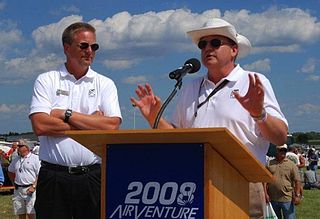
The Klapmeier brothers, Alan Lee Klapmeier and Dale Edward Klapmeier, are retired American aircraft designers and aviation entrepreneurs who together founded the Cirrus Design Corporation in 1984. Under the leadership of the Klapmeiers, Cirrus was the first aircraft manufacturer to install a whole-plane parachute recovery system as a standard on all its models—designed to lower the airplane safely to the ground in case of an emergency. The device is attributed with saving over 200 lives to date. From the brothers' use of all-composite airframe construction and glass panel cockpits on production aircraft, Cirrus is known for having revolutionized general aviation for modern light aircraft pilots.
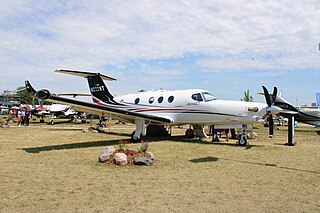
The Beechcraft Denali, also known as the Model 220 and previously the Cessna Denali and Textron "Single Engine Turboprop" (SETP), is an American single engine turboprop aircraft under development by Textron Aviation. Announced at EAA AirVenture Oshkosh 2015, the aircraft is a completely new design, not derived from any existing aircraft. It should compete primarily with the nine-passenger Pilatus PC-12 as well as slightly faster and smaller single-engine turboprops such as the Epic E1000, Piper M700 Fury, and SOCATA TBM.
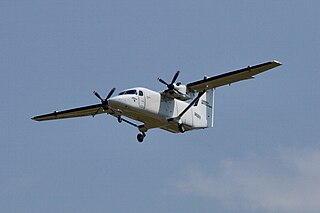
The Cessna 408 SkyCourier is an American utility aircraft designed and built by the Cessna division of Textron Aviation. It was launched on November 28, 2017, with an order for 50 from FedEx Express, with the aircraft designed for the needs of its FedEx Feeder service. It made its first flight on May 17, 2020, and was type certified on March 11, 2022. FedEx took delivery of the first production model on May 9, 2022.
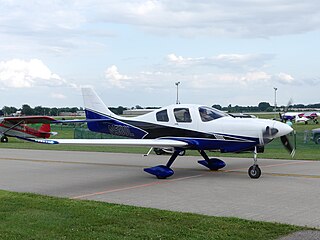
The Lancair Mako is an American amateur-built aircraft designed and produced by Lancair of Uvalde, Texas, introduced at AirVenture in 2017. The aircraft was first flown on 18 July 2017 and is supplied as a kit for amateur construction. It is named after the shark.

Doña Ana County International Jetport is a public-use airport located 4 mi (6.4 km) northwest of Santa Teresa, New Mexico, United States.


















